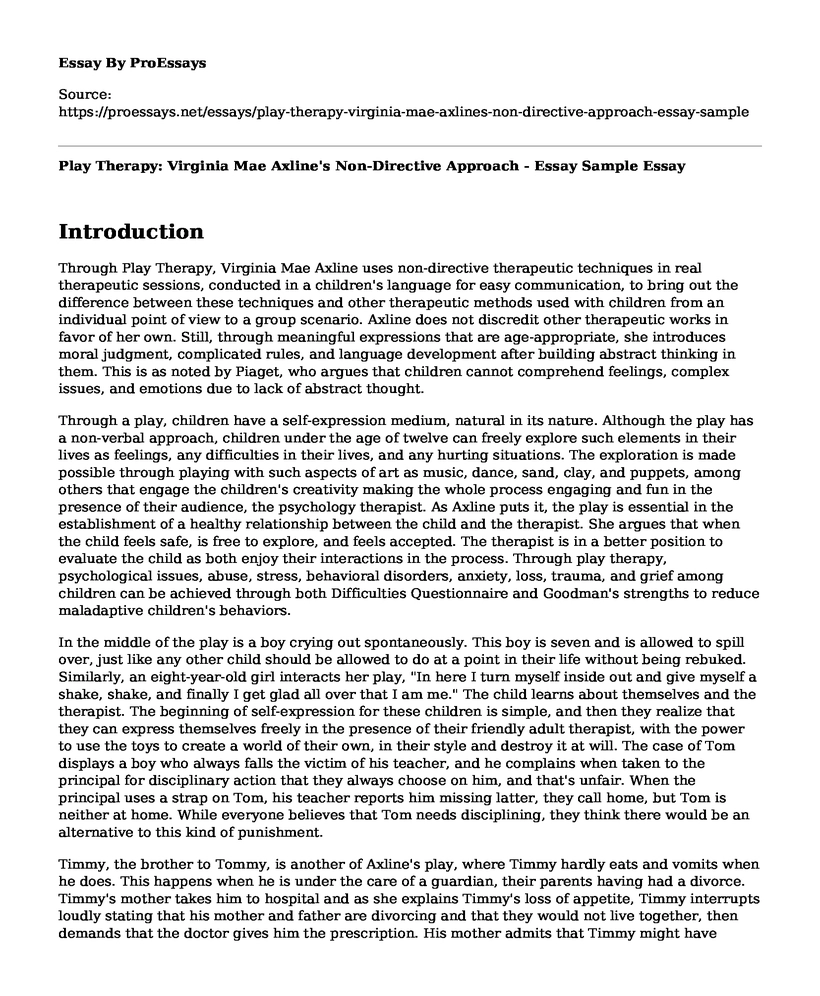Introduction
Through Play Therapy, Virginia Mae Axline uses non-directive therapeutic techniques in real therapeutic sessions, conducted in a children's language for easy communication, to bring out the difference between these techniques and other therapeutic methods used with children from an individual point of view to a group scenario. Axline does not discredit other therapeutic works in favor of her own. Still, through meaningful expressions that are age-appropriate, she introduces moral judgment, complicated rules, and language development after building abstract thinking in them. This is as noted by Piaget, who argues that children cannot comprehend feelings, complex issues, and emotions due to lack of abstract thought.
Through a play, children have a self-expression medium, natural in its nature. Although the play has a non-verbal approach, children under the age of twelve can freely explore such elements in their lives as feelings, any difficulties in their lives, and any hurting situations. The exploration is made possible through playing with such aspects of art as music, dance, sand, clay, and puppets, among others that engage the children's creativity making the whole process engaging and fun in the presence of their audience, the psychology therapist. As Axline puts it, the play is essential in the establishment of a healthy relationship between the child and the therapist. She argues that when the child feels safe, is free to explore, and feels accepted. The therapist is in a better position to evaluate the child as both enjoy their interactions in the process. Through play therapy, psychological issues, abuse, stress, behavioral disorders, anxiety, loss, trauma, and grief among children can be achieved through both Difficulties Questionnaire and Goodman's strengths to reduce maladaptive children's behaviors.
In the middle of the play is a boy crying out spontaneously. This boy is seven and is allowed to spill over, just like any other child should be allowed to do at a point in their life without being rebuked. Similarly, an eight-year-old girl interacts her play, "In here I turn myself inside out and give myself a shake, shake, and finally I get glad all over that I am me." The child learns about themselves and the therapist. The beginning of self-expression for these children is simple, and then they realize that they can express themselves freely in the presence of their friendly adult therapist, with the power to use the toys to create a world of their own, in their style and destroy it at will. The case of Tom displays a boy who always falls the victim of his teacher, and he complains when taken to the principal for disciplinary action that they always choose on him, and that's unfair. When the principal uses a strap on Tom, his teacher reports him missing latter, they call home, but Tom is neither at home. While everyone believes that Tom needs disciplining, they think there would be an alternative to this kind of punishment.
Timmy, the brother to Tommy, is another of Axline's play, where Timmy hardly eats and vomits when he does. This happens when he is under the care of a guardian, their parents having had a divorce. Timmy's mother takes him to hospital and as she explains Timmy's loss of appetite, Timmy interrupts loudly stating that his mother and father are divorcing and that they would not live together, then demands that the doctor gives him the prescription. His mother admits that Timmy might have heard them argue, but she insists that the boys would have come to learn of the divorce even without having listened to the parents arguing. This boy needs no medicine, the doctor states.
Conclusion
In conclusion, Axline uses the plays to show that children are continually growing towards their unique personalities. It is this growth that could be confusing to an observer and that in the process, "...He is both humble and proud, courageous and afraid, dominant and submissive, curious and satisfied, eager and indifferent. He loves and hates and fights and makes peace..." Children use this as a way to assimilate all the elements of their personality. Therefore, like any other organism, the child will strive to satisfy such basic needs to be well adjusted when they finally find their satisfaction. The implications for treatment in a therapeutic relationship is helping an individual, children, in this case, change for the better. To achieve this positive change in the behavior of children, Axline insists that there must be respect, trust, but have boundaries that define the acceptable from unacceptable behavior. All these elements of a therapeutic relationship are achieved through the Play Therapy by the open and non-judgmental atmosphere that Axline creates.
References
Axline, V. M. (1969). Play therapy (Vol. 125). Ballantine Books.
Cite this page
Play Therapy: Virginia Mae Axline's Non-Directive Approach - Essay Sample. (2023, Apr 28). Retrieved from https://proessays.net/essays/play-therapy-virginia-mae-axlines-non-directive-approach-essay-sample
If you are the original author of this essay and no longer wish to have it published on the ProEssays website, please click below to request its removal:
- The Deception of Participants Implying the Transgression of the Informed Consent Norm
- How to Handle the Injury and Illness Incident Paper Example
- Paper Example on Non-Profits: Working on Grounds of Charity?
- Essay Sample on Discovering Haiti: A Multicultural Nursing Course Exploration
- Tuberculosis: Global Concern & Its Epidemiology - Essay Sample
- Essay Example on Obesity Epidemic: Diet, Exercise & Bariatric Surgery
- Paper on Analyzing Resuscitation Plans in End-of-Life Decisions: Considerations for Future Healthcare Practices







